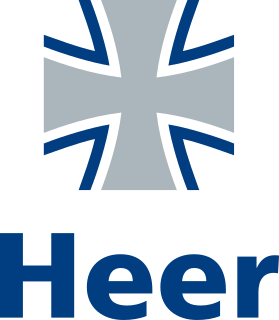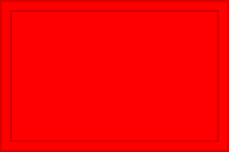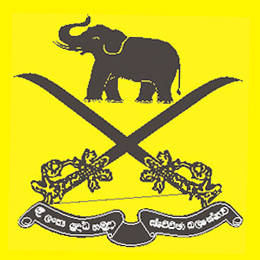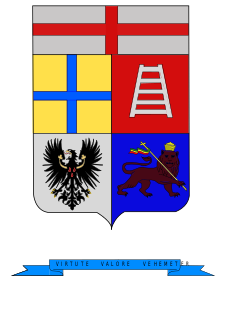
The Infantry of the British Army, comprises 49 infantry battalions, from 19 regiments. Of these, 33 battalions are part of the Regular army and the remaining 16 a part of the Army Reserve. The British Army's Infantry forms a highly flexible organisation, taking on a variety of roles, including armoured, mechanised, air assault and light.
A division is a large military unit or formation, usually consisting of between 6,000 and 25,000 soldiers.

A brigade is a major tactical military formation that is typically composed of three to six battalions plus supporting elements. It is roughly equivalent to an enlarged or reinforced regiment. Two or more brigades may constitute a division.

The German Army is the land component of the armed forces of Germany. The present-day German Army was founded in 1955 as part of the newly formed West German Bundeswehr together with the Marine and the Luftwaffe. As of April 2020, the German Army had a strength of 64,036 soldiers.

The 1st Canadian Division is an operational command and control formation of the Canadian Joint Operations Command, based at CFB Kingston.

The Turkish Land Forces, or Turkish Army, is the main branch of the Turkish Armed Forces responsible for land-based military operations. The army was formed on November 8, 1920, after the collapse of the Ottoman Empire. Significant campaigns since the foundation of the army include suppression of rebellions in southeastern Turkey from the 1920s to the present day, combat in the Korean War, the 1974 Turkish invasion of Cyprus and the current Turkish involvement in the Syrian Civil War, as well as its NATO alliance against the USSR during the Cold War. The army holds the preeminent place within the armed forces. It is customary for the Chief of the General Staff of the Turkish Armed Forces to have been the Commander of the Turkish Land Forces prior to his appointment as Turkey's senior ranking officer. Alongside the other two armed services, the Turkish Army has frequently intervened in Turkish politics, a custom that is now regulated to an extent by the reform of the National Security Council. The current commander of the Turkish Land Forces is General Ümit Dündar.

The Syrian Army, officially the Syrian Arab Army (SAA), is the land force branch of the Syrian Armed Forces. It is the dominant military service of the four uniformed services, controlling the most senior posts in the armed forces, and has the greatest manpower, approximately 80 percent of the combined services. The Syrian Army originated in local military forces formed by the French after World War I, after France obtained a mandate over the region. It officially came into being in 1945, before Syria obtained full independence the following year.

The Sri Lankan Army (SLA) is the oldest and largest of the Sri Lanka Armed Forces. Established as the Ceylon Army in 1949, it was renamed when Sri Lanka became a republic in 1972. In 2010, the Army had approximately 200,000 regular personnel, between 20,000 and 40,000 reserve (volunteer) personnel and 18,000 National Guardsmen and comprises 13 operational divisions, one air-mobile brigade, one commando brigade, one special forces brigade, one independent armored brigade, three mechanized infantry brigades and over 40 infantry brigades. From the 1980s to 2009 the army was engaged in the Sri Lankan Civil War.

The Sri Lanka Armoured Corps (SLAC) provides the armour capability of the Sri Lanka Army, with vehicles such as the T-55AM2, and ZTZ88 main battle tanks main battle tanks; the BMP infantry fighting vehicle; and the BTR-80, and WZ551 armoured personnel carriers. It comprises six regular armoured regiments, a volunteer regiment, and a regimental band. It has an independent Armoured Brigade and is headquartered at Rock House Army Camp, Colombo.

The Sri Lanka Army Volunteer Force (SLAVF) is the active-duty volunteer reserve force of the Sri Lanka Army. The SLAVF is separate from the Regular Force which consists of personal who are professional soldiers and its Regular Reserve, which comprises personal who have a mobilization obligation following their service in the regular army. The SLAVF consists of the volunteer force and the volunteer reserve; administration and recruitment of reserve personal is carried out by the Volunteer Force Headquarters in Shalawa, Kosgama which is headed by the Commandant of the Volunteer Force. It has a current strength of about 55,000 personnel.

The Airmobile Brigade "Friuli" is an airmobile brigade of the Italian Army, based mainly in the Emilia-Romagna region. The brigade was part of the 1st Defence Forces Command until it was transferred to the Division "Friuli". The brigade's coat of arms depicts a stylized version of the Rocca di Monfalcone castle near the city of Monfalcone in the Friuli region, where the brigade distinguished itself during World War I. Since 1 July 2019 the brigade is part of the Division "Vittorio Veneto".
The Mechanized Infantry Brigade is a mechanized infantry formation of the Sri Lanka Army. This grouping created a highly mobile brigade equipped with Type 63, BMP-2 and WZ551 armoured personnel carriers.

The Armored Brigade "Centauro" was an armored brigade of the Italian Army. Originally raised in 1975 as 31st Armored Brigade "Curtatone" it changed its name in 1986 when the Armored Division "Centauro" was disbanded. The brigade's headquarters was in the city of Novara and most of its tank and Bersaglieri units were based in the nearby city of Bellinzago Novarese, both located in the Province of Novara. The brigades name comes from the mythological race of half human-half horse creatures named Centaurs.

The Armored Brigade "Vittorio Veneto" was an armored brigade of the Italian Army. Its core units were armored and mechanized cavalry squadrons groups. The brigade's headquarters was in the city of Villa Opicina, with most of its units based in the Province of Trieste. The brigade's name was chosen to remember the decisive Italian World War I victory at the Battle of Vittorio Veneto.

The Mechanized Brigade "Gorizia" was a mechanized brigade of the Italian Army. Its core units were mechanized infantry battalions. The brigade's headquarters was in the city of Gorizia and the brigade's units were based in the region of Friuli-Venezia Giulia. The brigade's name was chosen in memory of the World War I Battle of Gorizia. The brigade's sister brigade, the Armored Brigade "Vittorio Veneto", was named to commemorate the World War I Battle of Vittorio Veneto.

The Mechanized Brigade "Goito" was a mechanized brigade of the Italian Army. Its core units were mechanized Bersaglieri battalions. The brigade's headquarters was in the city of Milan. The brigade's name was chosen in memory of the First Italian War of Independence Battle of Goito, where the Bersaglieri corps had its baptism of fire.

The 3rd Army Corps was one of three corps the Italian Army fielded during the Cold War. Based in the regions of Lombardy and Piemont the corps was the army's operational reserve, while the 4th Alpine Army Corps and the 5th Army Corps, both based in the North East of Italy, were the army's front-line units. After the end of the Cold War the corps was reduced in size and on 1 December 2000 it ceded its last brigades to the 1st Defence Forces Command. The personnel of the 3rd Army Corps was used to raise the NATO Rapid Deployable Italian Corps in January 2001.

The Mechanized Brigade "Legnano" was a mechanized brigade of the Italian Army. Its core units were mechanized infantry battalions. The brigade's headquarters was in the city of Bergamo in Lombardy. The name of the brigade commemorates the Lombard League victory in the Battle of Legnano in 1176 and its coat of arms depicts the Monument to the Warrior of Legnano in the centre of Legnano.

The Mechanized Division "Folgore" was a mechanized division of the Italian Army. Its core units were three mechanized brigades. The brigades headquarters was in the city of Treviso.




















